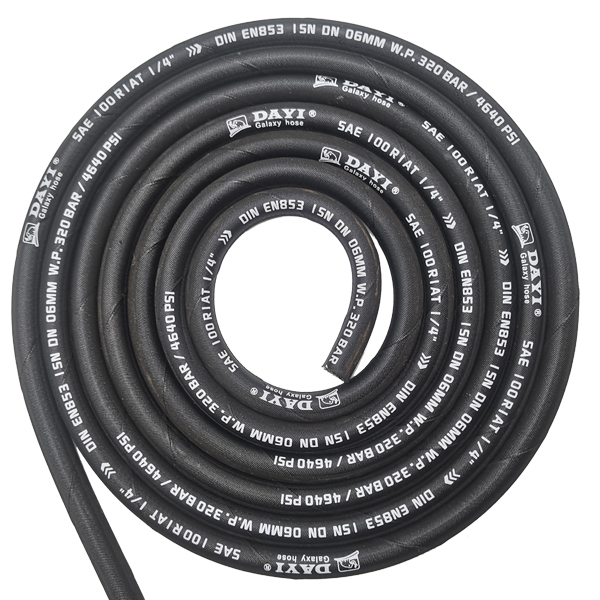335345435
Oct . 11, 2024 08:17 Back to list
High Pressure Hydraulic Hose Manufacturers with Two Wire Braiding Techniques
The Importance of Two-Wire Braided High-Pressure Hydraulic Hoses An Overview of Factories and Manufacturing
Hydraulic hoses play a crucial role in modern machinery and equipment, enabling efficient transfer of hydraulic fluids under high pressure. Among the various types of hydraulic hoses available in the market, two-wire braided high-pressure hydraulic hoses are particularly noteworthy due to their superior strength, flexibility, and durability. This article explores the significance of these hoses, the factors that influence their manufacturing, and insights into the factories producing them.
The Structure and Benefits of Two-Wire Braided Hoses
Two-wire braided hydraulic hoses are designed with two layers of steel wire reinforcement braiding, which enhances their ability to withstand high pressure. This construction allows them to handle pressures exceeding 3000 PSI, making them suitable for demanding applications in industries such as construction, agriculture, and manufacturing.
One of the primary benefits of these hoses is their flexibility. Unlike rigid piping systems, hydraulic hoses can bend and twist, making them ideal for use in equipment where space is limited or components are in motion. Additionally, the two-wire braided design offers excellent resistance to abrasion, reducing the likelihood of wear and tear, which can lead to leaks and failures.
Manufacturing Processes in Factories
The production of two-wire braided high-pressure hydraulic hoses involves several key steps, each vital to ensuring the quality and performance of the final product. First, the base materials, including synthetic rubber and steel wire, are carefully selected for their properties. The rubber provides flexibility and resistance to hydraulic fluids, while the steel wire offers the strength needed to withstand high pressure.
The manufacturing process begins with the extrusion of the rubber layer, which forms the inner tube of the hose. Once the rubber is extruded, the steel wires are wrapped around it in a precise manner to create the two-wire braid. This braiding process requires specialized machinery and skilled operators to ensure that the wires are evenly distributed and tightly woven.
After the braiding is completed, an additional layer of rubber is often applied to protect the steel wire and provide an outer cover that enhances the hose's durability and resistance to environmental factors such as UV rays and chemicals. Once the hose is fully assembled, it undergoes rigorous testing to confirm its performance under high-pressure conditions, ensuring that it meets industry standards and safety regulations.
two wire braided high pressure hydraulic hose factories

Quality Control and Assurance
Quality control is a critical aspect of manufacturing hydraulic hoses. Factories producing two-wire braided hoses implement strict quality assurance protocols to monitor every stage of production. This includes testing materials for tensile strength, flexibility, and resistance to abrasion and oil. Additionally, pressure tests are conducted on finished hoses to ensure they can withstand the stresses they will face in real-world applications.
Factories often adhere to international standards such as ISO 9001, which outlines requirements for effective quality management systems. By certifying their processes and products, manufacturers not only enhance their reputation but also ensure reliability and safety for their customers.
The Future of Hydraulic Hose Manufacturing
As technology continues to evolve, the production of two-wire braided high-pressure hydraulic hoses is set to benefit from advancements in materials science and manufacturing techniques. Innovations in composite materials may lead to lighter yet stronger hoses, while automation in factories could improve efficiency and consistency.
Furthermore, the growing emphasis on sustainability will likely influence manufacturers to adopt eco-friendly practices and materials in their production processes. By focusing on reducing waste and improving energy efficiency, factories can contribute to a more sustainable future while still meeting the demands of a rapidly evolving industry.
Conclusion
Two-wire braided high-pressure hydraulic hoses are essential components in a vast array of industrial applications, offering unparalleled strength and flexibility. Factories dedicated to their production play a pivotal role in ensuring that these hoses meet rigorous quality standards and the ever-increasing demands of modern engineering. As the industry advances, the ongoing pursuit of innovation and sustainability will undoubtedly shape the future of hydraulic hose manufacturing.
-
SAE 100 R17 Black Smooth Cover Hydraulic Hose
NewsMar.07,2025
-
SAE 100 R17 Black Smooth Cover Hydraulic Hose
NewsMar.07,2025
-
SAE 100 R17 Black Smooth Cover Hydraulic Hose
NewsMar.07,2025
-
SAE 100 R17 Black Smooth Cover Hydraulic Hose
NewsMar.07,2025
-
SAE 100 R17 Black Smooth Cover Hydraulic Hose
NewsMar.07,2025
-
steel wire braided hydraulic hose
NewsMar.07,2025



